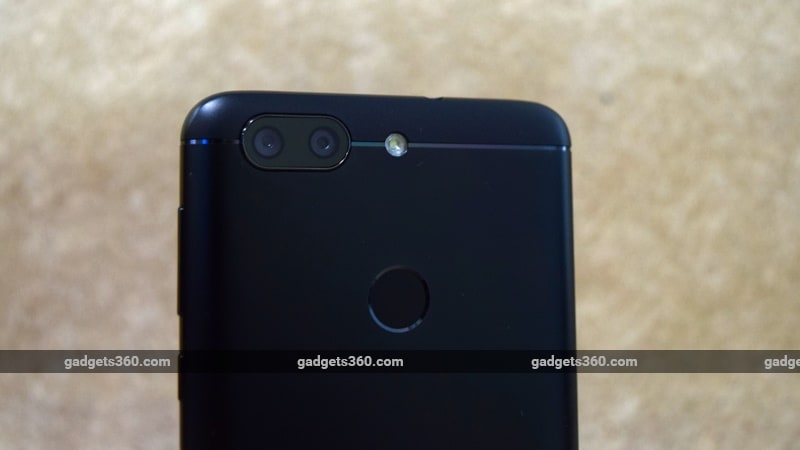Infoxed to compete all these Vision 3 ProBut is this phone made to combat smartphones in the market? We investigated …
Infocus Vision 3 Pro Design
The body of Infocus Vision 3 is of plastic but it seems to be upgraded. It has a metal backplate in its back, which gives a premium feel as soon as the phone is taken in hand. The top and bottom have plastic caps for antenna. The front has a 5.7 -inch display, with a mixture of colors better and the viewing angle is also good. The display is also visible in the sun. There is an option to adjust the color temperature. Also, the display output can also be converted from standard to dynamic.
The buttons given in Vision 3 Pro are at some high, due to which the thumb has to be drawn a lot. In Vision 3 Pro, Infocus has given the micro-USB port below. There are two grills together, out of which the left has loudspeakers. The 3.55 mm headphone is given on the jack top. The selfie camera is on one side. The notiopiation is given next to LED earpiece.
On the left side of the phone is a hybrid dual sim tray, with 1 micro-slot for the first SIM and the second is for the next nano slim. Memory cards can be used in another slot. The back of Vision 3 Pro has dual cameras and an LED flash. Fingerprint scanner is also given in the back itself.
18: 9 aspect ratio makes the phone long and thin, it makes the phone extremely easy to catch. Its round ages and the phone is quite light. In the box, the user gets micro-USB cable, 7.5 watt charger, earphones. The quality of accessories is not good and the headphone sounds not as good.
Infocus Vision 3 Pro Specification and Feature
The features given in the phone justifies the ‘Pro’ given in its title. The phone works in the phone, while the Vision 3 comes with MT 6737H, the Vision 3 MediaTek. The phone has an Octacore processor. The processor is new and has so far been seen in Asus Zenfone 3s Max and Vivo V5S, which was launched last year. The phone has 4 GB RAM and 64 GB of storage, which is possible to increase up to 128 GB. Infocus Vision 3 Pro supports 4G and VoLTE works in both its SIMs.
In terms of software, the phone runs on Android 7.0 Nougat, which has been outdated since coming to Android Oreo. Infocus has added some customization to its OS. This does not have an app dra over in it and all the apps remain on homescreen. Blotware is kept in low, so that the user can get fun of Amazon shopping, Prime Video, UC Browser, Emkey Keyboard. It is a matter of relief that all of them can also be uninterrupted.
Infocus Vision 3 Pro Performance, Camera and Battery Life
The performance of Vision 3 Pro is much better than Vision 3. The processor is new and is capable of giving better experience. Messages and common web browsing on social media is better with its help. However, some apps are stuck due to walking in the background, which despite having 4 GB of RAM. Vision 3 Pro is easily supported, but games like shadow fight 3 start getting stuck in it.
Battery life depends on your use. It costs quickly to run games, heavy apps. We found that the phone gets hot in playing the game for 15 minutes. In our video loop test, Vision 3 Pro lasted for 12 hours 8 minutes. It runs throughout the day with common use. If you play the game then it is difficult for the phone to walk all day, you will need a charger for some time.
The rear of Vision 3 Pro has a dual camera setup. It is a 13+8 megapixel sensor, which comes with a wide angle lens. Apart from standard photos and video modes, it has been added to Time-Laps, Beauty, Panorama, Pro mode. HDR is available but it takes some time. We expected response a little early from this. Photos taken from primary sensor were good but landscape shots showed lack of clarity. Secondary sensor with the help of wide angle lens facilitates wider frame to the user. There is also a lack of details here. Secondary sensor equipped with autofocus is slow compared to primary. There was a slight interruption in taking portrait photos. Its edge detection requires improvement. Macro shot was better. In these, the difference between the subject and the background was clearly understood.
The camera performance is not good in low light. Vision 3 Pro controls the noise but the details decreases. Video recording goes up to 1080 pixels, supporting both cameras. But the Redmi Note 5 provides 4K video recording in this list. There is no stabilization feature, so that the hand will have to be kept stable. The 13 -megapixel selfie camera takes good photos. Beauty mode automatically becomes active. Zoom in tax can lose details of selfie but still get shared pictures on social media.
Decision
Vision 3 Pro is an upgrade to its previous smartphone Vision 3, which has got strong processor, more RAM has been found. However, the competition has been increased by Redmi 5 and Redmi Note 5. The recently launched Asus Zenfone Max Pro M1 also challenges Vision 3 Pro for Rs 10,999. If you are looking for a budget smartphone in the market, then you can move to Zenfone Max Pro M1, except Vision 3 Pro.

